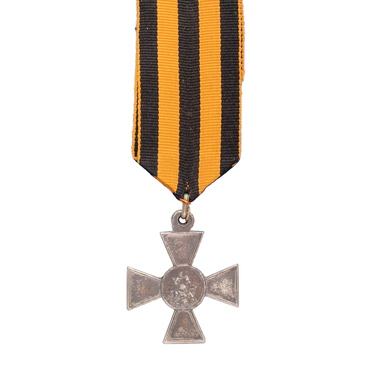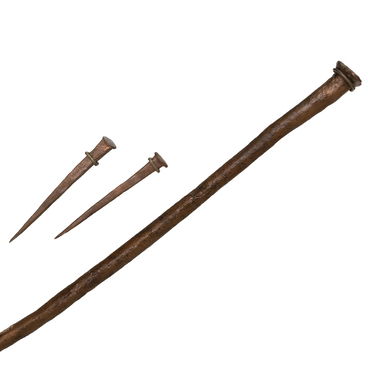In the Russian army, in addition to individual awards (orders and medals), some decorations were awarded to whole military units for their bravery. The museum exhibition presents one of these decorations, which dates to the mid-19th century. This award was attached to a headdress.
The decoration is a curved metal band with the edges folded up and split at the end. In the center, there is a carved inscription “За отличие” (For Distinction). An embossed rim trims the edges. On the reverse side of the product, there are traces of solder — an alloy used to connect the workpieces.
In the Russian army, collective awards began to be awarded at the beginning of the 13th century. They were given to distinguished units, for example, infantry troops, battalions, squadrons, hundreds, companies or regiments, as well as ship or naval crews. The awards could be silver trumpets and horns, banners and flags, transfer to the Guards and Grenadier regiments and honorifices. They also included special external differences, usually elements of a uniform. They pointed out that the entire military unit had shown heroism in battle.
The decoration in the form of a ribbon, which is kept in the museum’s collection, was established in 1828. On the eve of the Crimean War in the Russian army, it was worn by soldiers of 12 infantry, 12 jaeger, 18 cavalry regiments and 30 artillery batteries. Some of them were on the territory of Crimea during the hostilities.
The first regiment to receive a metal decoration on its headdress was the 20th Jaeger Regiment. On December 4, 1812, with the highest permission, officers and lower ranks were ordered to issue badges with the inscription “За храбрость” (For Bravery). In total, 70 units were awarded honorary metal badges for headdresses for the war of 1812–1814.
Sometimes collective awards were also given after lost military campaigns if troops showed their quality in battles and fought bravely. These included, for example, the collective awards that were awarded to the Russian army in the Eastern War of 1853–1856.
The decoration is a curved metal band with the edges folded up and split at the end. In the center, there is a carved inscription “За отличие” (For Distinction). An embossed rim trims the edges. On the reverse side of the product, there are traces of solder — an alloy used to connect the workpieces.
In the Russian army, collective awards began to be awarded at the beginning of the 13th century. They were given to distinguished units, for example, infantry troops, battalions, squadrons, hundreds, companies or regiments, as well as ship or naval crews. The awards could be silver trumpets and horns, banners and flags, transfer to the Guards and Grenadier regiments and honorifices. They also included special external differences, usually elements of a uniform. They pointed out that the entire military unit had shown heroism in battle.
The decoration in the form of a ribbon, which is kept in the museum’s collection, was established in 1828. On the eve of the Crimean War in the Russian army, it was worn by soldiers of 12 infantry, 12 jaeger, 18 cavalry regiments and 30 artillery batteries. Some of them were on the territory of Crimea during the hostilities.
The first regiment to receive a metal decoration on its headdress was the 20th Jaeger Regiment. On December 4, 1812, with the highest permission, officers and lower ranks were ordered to issue badges with the inscription “За храбрость” (For Bravery). In total, 70 units were awarded honorary metal badges for headdresses for the war of 1812–1814.
Sometimes collective awards were also given after lost military campaigns if troops showed their quality in battles and fought bravely. These included, for example, the collective awards that were awarded to the Russian army in the Eastern War of 1853–1856.



